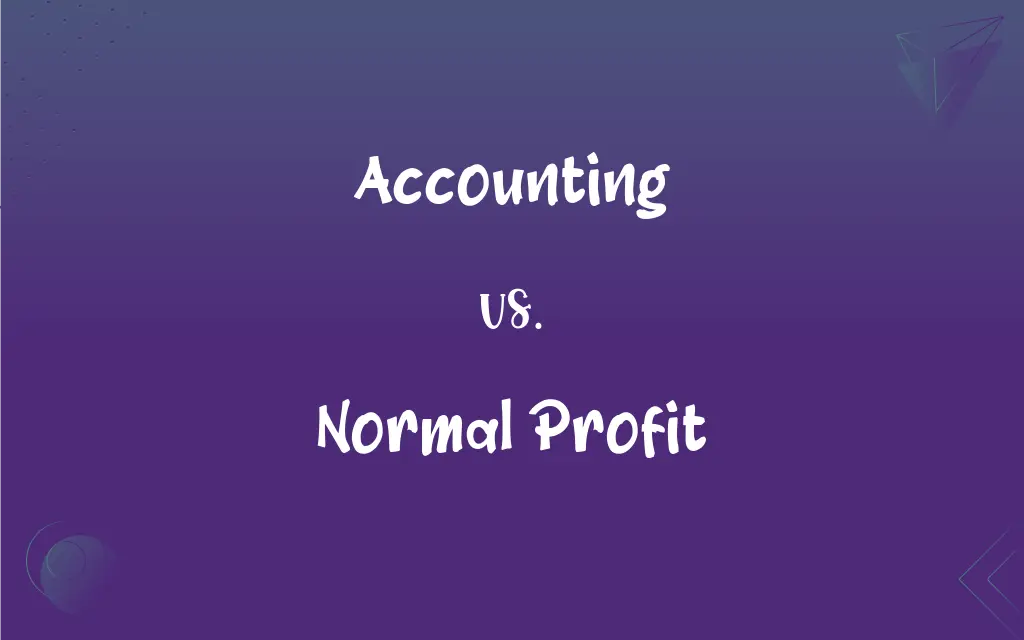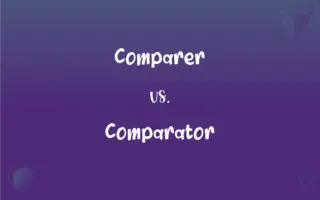Accounting vs. Normal Profit: What's the Difference?
Edited by Janet White || By Harlon Moss || Updated on October 26, 2023
Accounting profit is total revenue minus explicit costs, while normal profit is the minimum earnings needed to keep a firm in operation.

Key Differences
Accounting profit measures a company's financial performance by calculating total revenue minus explicit costs. Normal profit, on the other hand, is an economic concept representing the minimum earnings needed to keep a business in operation.
Normal profit is included in a firm’s total costs, serving as a component of its break-even analysis. In contrast, accounting profit appears on a company’s financial statements, showing the surplus after all explicit expenses are deducted.
In calculating accounting profit, only tangible, monetary costs are considered. Normal profit, however, encompasses the opportunity costs, including the income a business owner could have earned elsewhere.
Accounting profit is a more straightforward, fiscal-centric calculation. Conversely, normal profit delves into the realm of economic theory, where implicit costs and opportunity costs are vital components.
Normal profit is essential for the long-term sustainability of a business, while accounting profit indicates its immediate financial health and profitability to investors and stakeholders.
ADVERTISEMENT
Comparison Chart
Nature
Monetary, explicit costs only
Includes opportunity costs
Calculation
Revenue minus explicit costs
Break-even point considering all costs
Purpose
Measures financial performance
Indicates business sustainability
Presentation
In financial statements
In economic analysis
Focus
Short-term profitability
Long-term viability
ADVERTISEMENT
Accounting and Normal Profit Definitions
Accounting
Reporting financial outcomes.
Accounting is crucial for preparing annual financial reports.
Normal Profit
Break-even earnings.
Achieving normal profit means the café covered its costs.
Accounting
Analyzing financial data.
Accounting involves analyzing expense reports for budgeting.
Normal Profit
Threshold for business viability.
Normal profit is essential for the grocery store's survival.
Accounting
Recording financial transactions.
The company's accounting department ensures all sales are properly recorded.
Normal Profit
Opportunity cost of capital.
Normal profit accounts for the income the owner foregoes.
Accounting
Advising on financial decisions.
Good accounting practices help guide investment decisions.
Normal Profit
Benchmark for economic success.
Surpassing normal profit indicates economic growth for the firm.
Accounting
Summarizing economic activities.
Accounting provides a summary of the firm's financial operations.
Normal Profit
Minimum earnings for business continuity.
The shop made just enough for normal profit this quarter.
Accounting
The practice or profession of maintaining the financial records of a business, including bookkeeping as well as the preparation of statements concerning the assets, liabilities, and operating results.
FAQs
How is accounting profit calculated?
Accounting profit is calculated by subtracting explicit costs from total revenue.
What does normal profit include?
Normal profit includes opportunity costs and implicit costs.
What is normal profit?
Normal profit is the minimum earnings a business needs to remain operational.
What is accounting?
Accounting is the systematic recording and analysis of financial transactions.
Is normal profit the same as net profit?
No, normal profit is not the same as net profit; it's a break-even point.
Does normal profit mean no real profit?
Yes, normal profit indicates breaking even, not making extra profit.
Are accounting standards the same worldwide?
No, accounting standards can vary, though many countries adopt IFRS or GAAP.
Why is accounting important?
Accounting is crucial for financial reporting, decision-making, and compliance.
Can a business have high accounting profit but low normal profit?
Yes, if the opportunity costs are high, this scenario is possible.
Is normal profit a part of total costs?
Yes, normal profit is considered in the total costs for economic analysis.
What’s the difference between accounting and normal profit?
Accounting profit is actual surplus after explicit costs; normal profit is break-even earnings considering all costs.
Does normal profit vary by industry?
Yes, normal profit thresholds can differ based on industry dynamics and risks.
What role does accounting play in investment decisions?
Accounting provides financial insights crucial for informed investment decisions.
How does accounting affect taxation?
Accounting determines taxable income and compliance with tax laws.
Does accounting only deal with past transactions?
No, accounting also involves forecasting and budgeting for future financial planning.
Can a company survive on just normal profit?
Yes, but it implies no extra earnings above break-even.
Do non-profits need accounting?
Yes, non-profits still require accounting for financial management and transparency.
How does technology impact accounting?
Technology streamlines accounting processes, improving accuracy and efficiency.
Why might normal profit be considered an implicit cost?
It represents the income foregone by not investing elsewhere.
Is achieving normal profit a good sign for startups?
Yes, it indicates sustainability, but growth requires surpassing normal profit.
About Author
Written by
Harlon MossHarlon is a seasoned quality moderator and accomplished content writer for Difference Wiki. An alumnus of the prestigious University of California, he earned his degree in Computer Science. Leveraging his academic background, Harlon brings a meticulous and informed perspective to his work, ensuring content accuracy and excellence.
Edited by
Janet WhiteJanet White has been an esteemed writer and blogger for Difference Wiki. Holding a Master's degree in Science and Medical Journalism from the prestigious Boston University, she has consistently demonstrated her expertise and passion for her field. When she's not immersed in her work, Janet relishes her time exercising, delving into a good book, and cherishing moments with friends and family.
































































